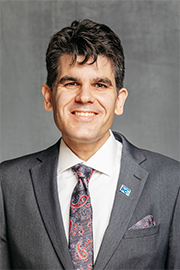- Feb/29/24 2:20:00 p.m.
- Re: Bill 162
I want to thank both speakers for their comments. I’ll say this: Having worked in the municipality and having to come against some of the environmental assessment restrictions that do add costs that could otherwise be better spent on actual environmental remediation, do you see an opportunity nonetheless in improving the regulations that do exist so that we’re not spending far more without a resulting outcome, and we’re simply spending more on a project?
I think one of the most controversial projects that I had back in my former council ward in the town of Tecumseh was the construction of a multi-use path alongside Riverside Drive. That is an identified route for the Trans Canada Trail, the Great Lakes Waterfront Trail, and soon, hopefully, we will get some connectivity with the rest of the trail, once the gaps get filled in.
One of the most strenuous debates was with a couple of people who I know well. They’re really very partisan Liberal activists, but they did not approve of the use of the municipal class environmental assessment A+ schedule, which actually pre-authorizes multi-use trails. They thought the trail needed to have a more thorough investigation as to the impacts of public safety and security, health, environment—for example, will a 12-foot path have a significant amount of runoff that would cause flooding or give cause for flooding? This trail ended up being a debate for probably two and a half years, at which point, when it was finally done, the escalation and price that we’ve seen in construction increased the cost by about $1.5 million. Initially, it looked like it was coming in over budget. The federal government gave a grant, but then that was all eaten away and then some by just the consumer price index increases. Ultimately, we had the same result, but the way that—who could know? If we still had to go through a schedule B municipal class environmental assessment, that would have added a significant amount of time to getting this trail built and connecting to the great trails that we have in our glorious country.
And so, when I see opportunities to streamline the environmental assessment, do just like what the McGuinty government did and introduce schedule A prime, that’s a good thing—because there are certain projects that you will undertake in a municipality that are routine. They’re the same every single time.
I designed sewers and sewer systems. I designed bike paths. I didn’t design a building in full, but I administered the project. That particular project, I’ll get into a bit later, but do you know what? When I design a sewer, I submit to the MECP for my approval. It is a very set process. You know what the application is, you submit your drawings, you submit your sewer design sheets and you have certainty. The only thing you are uncertain about is the review timeline from the ministry.
Now, with recent changes, the linear assets evolution at the ministry, that’s actually left in the hands of the municipality. I see that as, again, a good thing. A professional engineer must stamp a drawing and a design. It doesn’t matter how long ago I did that design; I’m responsible if I fail in my job, in my duty as a professional engineer.
So when one approaches engineering design with a lens of skepticism, that we’re all unethical as engineers when we design—and unfortunately, I’ve heard that sort of suggestion in a couple of debates that we’ve had. I’ll say, number one, I want to serve the public as a professional engineer, and those who are involved with environmental assessments want to serve the public too. It doesn’t matter if you’re a land use planner—sometimes it’s a biologist—you take your knocks.
Going through the process, public consultation, is a key part of the environmental assessment process. You have to go through it. Schedule B: You’re required to do one project meeting and then you can create a project file at the tail end. Schedule C: You have to have a minimum of two public meetings and do a thorough report. Now, as a fail-safe, you want to do a whole report just in case there is a—it used to be a bump-up request that the minister used to deliver; now, again, that’s the decision of council.
At the end of the day, you do a biological assessment. You do an archaeological assessment. You do a storm water assessment. You do a traffic assessment. You spend a lot of money on studies to make sure that things are going right. It’s clockwork when you have a process that is set and established. You know what you need to do. So in the case of what the previous government did with schedule A-1, again, it’s a good thing. I support it. It means that what is routine and default should not result in unnecessary delays to achieving the societal good that your project would bring in.
Changes to the EA process to provide a wider breadth of scoped projects, ones where you know what you’re getting—a waste water treatment facility—you get newer technology, but, fundamentally, you can write out the design with a pen and paper. You know what the processes are for cleaning water. You know you have primary treatment. Ideally, you will have secondary treatment. In a perfect world, maybe we’d have tertiary treatment; that isn’t compulsory. But the secondary treatment is one where you can decide: Do you use light? Do you use ultraviolet? Do you use ozonation? Do you use membrane technology? It doesn’t matter. At the end of the day, there are only so many technologies out there and so many directions you can go down.
There are certainly opportunities to standardize a process, to introduce a quicker process and to ensure that you don’t run into unnecessary delays and barriers in trying to achieve public good. Cleaning water is a public good. Providing a bike lane is a public good. And yes, building a neighbourhood street, rebuilding a neighbourhood street—hereby called a “highway,” but the Highway Traffic Act includes all roads, including that 20-foot-wide lane. That’s what a highway is. It’s not a freeway.
So at the end of the day, there are plenty of great reasons for which to make the kinds of changes that are being proposed here. It’s not just for municipal infrastructure; it’s private infrastructure as well. It’s actually—I call it more stringent, because now you have geotechnical reports, whether it’s private or public or municipal, but they go through more intensive environmental site assessments. You have to prove that there’s no contamination on your property. Like, if your property was a gas station at one point, hey, you need to clean that soil. Again, it comes back to, as a designer, as a professional, you’re not doing your job and you are unethical if you don’t do your due diligence.
Now, adding the kind of—call it “public contact points” and all of what that entails—there’s merit to having public consultation, but sometimes that public consultation is repetitive. If you’re trying to improve storm water or add active transportation facilities and people don’t like it, well, you’re going to have some battles in front of you. And you know what? You can solve those projects on a political basis: Tell your city council not to fund it. But to actually encumber the process by politicizing it, effectively, instead of making it on a technical basis isn’t the best approach. It’s one of the flaws that we’ve had in our environmental assessment system. I’m happy to see the depoliticization and standardization of environmental assessments that are being called for in this legislation.
Not only did I serve as councillor, but I served as a designer in the municipality. I worked with contractors of many types. I’m representing the public good. In fact, I was the drainage superintendent as well. I was the regulator. I would say no. I had to impose the conditions of the Drainage Act. A lot of them are costly, and people push back. And you know what? Sometimes I’d agree with them. We were creating work for the sake of creating work. There’s no measurable benefit.
I think of a culvert installation on a property that’s on a drain that was established 120 years ago. If someone wants to move that culvert, they can’t just move the culvert and replace like with like. They actually have to go and do an entire drainage assessment of the whole drain—the entire length—to see what the impact is, even though the culvert next door is the same size on both sides so this particular culvert change is not going to change the flow. That’s where engineering judgment comes into play.
You need to be sensible with your decision-making, and sometimes the rules that we have imposed upon ourselves really detract from that. They add costs. They add time. And that cost that you’re wasting could be used for actual environmental remediation, actual environmental improvement, not just bringing process into it and having study after study when you know it’s not necessary or, worse yet, it has no bearing.
It’s a pretty cumbersome process to develop a property today. I think of the fire hall project that I went through. I know I’ve heard some concerns over the prospect of—call it weakening environmental regulation and, particularly, species at risk. The municipality can afford to wait—I worked for a municipality—and put in the time and money. So when all was said and done, a $5-million fire station project that I had that was delayed for two and a half years because of the efforts to get a beneficial-use-impairment permit and all that entailed—which was a three-to-one land compensation elsewhere and 10 years of monitoring on-site for snakes, the willowleaf aster and Butler’s garter snake, in addition to a number of construction techniques that were explicitly developed to ensure no harming of the snakes. This was after we had spent 30 days with a person on the site visibly pulling out every snake we could find to be able to relocate them to the offset site.
So in compiling the costs, it was a full million dollars and counting for the future monitoring added to the project cost. I look back at that—we only have so much we have in our household. We earn a paycheque; we try to provide for our kids, we try to take care of our parents, and we want to do the best that we can for them. When we’re diverting funds to engage in activity that really accomplishes no environmental improvement, to me that doesn’t feel like a win.
Having the standardization, as this is proposing, will set clear rules and clear compensation for the environmental impact in a standardized way. You know what you’re getting into. You spend the money to achieve that environmental improvement. It’s very definitive. This is something that is a way to not only reduce the cost, which we all would love to do so we can invest in other things, but it also significantly reduces the time spent on a project.
My very first project, which was dealing with basement flooding—and I mean sanitary basement flooding—was back in 2006. There’s a company called Amico Infrastructures that was the first contractor that I dealt with. Not too long ago, in learning about the government’s changes, the president of that company actually submitted some comments about this legislation. Dominic Amicone, the president of Amico, said: “Environmental assessment processes exist to recognize and protect the sometimes-delicate balance of the environments in which our clients build and operate. These new MECP initiatives will help manage the equally delicate balance of streamlining development while ensuring appropriate environmental protections. Amico supports policy innovations that facilitate near-term initiatives and long-term sustainability.”
Amico is an expert on this, because they were also a contractor on the fire station; they’re the contractor on the Gordie Howe International Bridge that had a significant amount of compensation involved. In fact, we have a whole linear network of trails that was put in by the previous government. I give them full credit; they spent a ton of money taking care of the natural environment in Windsor and LaSalle. If you go down Highway 401, on your way to the new bridge—you can’t access it yet because it’s not built yet, but the rest of the freeway has been there for about 10 years now—you will see the environmental compensation. You will see the wildlife crossings that they have brought in and all of the offsets that that project entailed. There are, again, ways to standardize this type of compensation, where you set the rules in advance and you ensure that you deliver excellent value all across the board. So I’m very happy to see that Amico—this was unsolicited by me—came out and showed some support for this.
Further, municipalities get the phone calls, just like we get phone calls as MPPs. The city council just wants to see some achievements for their time, too, and their investment. Why does it take two, three, four years to resurface a street? I’m exaggerating a little bit with this; the street rehabilitation is pre-approved, but a street expansion is not. If you have a schedule B or a schedule C process, you are going to be spending an inordinate amount of time trying to reach a conclusion that you generally know is already going to work. Ultimately, you do need some degree of public consultation, but there are times when you need public consultation—other routine projects—where it really does not add value.
I’ve actually hosted, as I’ve administered environmental assessments under the MCEA—six people attended over a three-hour period, and their only ask was, “How much will it cost me?” So when I see that Bill 162 proposes to address some of these obvious deficiencies that we know we have and that municipalities support—actually, we’ve got AMO who says, “Modernized environmental assessment processes are a critical enabler for housing, streamlining processes for municipalities to help them build infrastructure like roads, sewers, and water systems more quickly. The initiatives announced today take a risk-based approach to environmental management, removing red tape for straightforward municipal infrastructure projects and focusing resources where they are needed most. AMO looks forward to continuing to work with the ministry on implementation details.” That’s Colin Best, AMO president and regional councillor for Halton. I know Mr. Best has been quoted extensively as being an expert in these chambers, and so I hope that Mr. Best’s contributions to this carry the same weight that they did for some of his previous comments on other pieces of legislation.
I see I’m running out of time. I just have about a minute left, and I only touched a small part of this bill. There’s a lot more—I think of road tolls. The city of Windsor would like to have tolls on E.C. Row Expressway to toll for the county residents who use that road. Obviously it’s not a provincial highway but, look, there’s a prospect and discussion for road tolls, and the government is saying very definitively this should not be part of our future. A gas tax is an absolutely more efficient way to raise funds. There’s a whole lot of infrastructure and paperwork involved with road tolls. So if you’re looking at the best way to actually levy a charge on a driver, the gas tax has the least amount of costs and has the most amount of revenue that you can carry forward.
There are arguments in favour of tolls; don’t get me wrong, but if you’re looking to make life easier for Ontarians, this is not the way to go. Anyway, thank you very much, Speaker.
- Hear!
- Rabble!
- Feb/29/24 4:30:00 p.m.
- Re: Bill 162
I couldn’t help notice that the member was quoting British Columbia. For British Columbia to achieve what they have, they have already been ahead of Ontario in terms of streamlining their environmental assessment process, which now we’re finally modernizing in Ontario after 50 years of not having this process embrace some new technologies to modernize it.
If you’re embracing your BC partners, who are doing such a great job on housing, shouldn’t we adopt practices like EA modernization, as well?
- Hear!
- Rabble!
- Feb/29/24 4:50:00 p.m.
- Re: Bill 162
My question, very quickly: This schedule 1 where they’re cutting the environmental assessment protections again—in it, they’re also giving the government more extraordinary power to expropriate land, and farmers along the route are concerned about that. What do you think about this government giving themselves the power to expropriate land even before they’ve done an environmental assessment?
- Hear!
- Rabble!
- Feb/29/24 5:30:00 p.m.
- Re: Bill 162
Thank you to the member from University–Rosedale for those scintillating words this afternoon. This government has done a lot of things, proposed a lot of policy, and then they’ve gone ahead, and they’ve come back and reversed it and gone ahead and reversed it, and people are losing trust out there. They just want to have a better, more sustainable Ontario. I’m just wondering, with the proposal to amend the Environmental Assessment Act, do you have faith that they will be able to do that or that they’re going to do that properly, safely, sustainably?
- Hear!
- Rabble!





